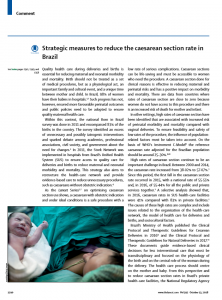
Quality health care during deliveries and births is essential for reducing maternal and neonatal morbidity and mortality. Birth should not be treated as a set of medical procedures, but as a physiological act, an important family and cultural event, and a unique time between mother and child. In Brazil, 98% of women have their babies in hospitals. Such progress has not, however, ensured more favourable perinatal outcomes and public policies need to be adopted to ensure quality maternal health care.
Within this context, the national Born in Brazil survey was done in 2011 and encompassed 83% of the births in the country. The survey identified an excess of unnecessary and possibly iatrogenic interventions and sparked debate among academics, professional associations, civil society, and government about the need for changes. In 2011, the Stork Network was implemented in hospitals from Brazil’s Unified Health System (SUS) to ensure access to quality care for deliveries and births to reduce maternal and neonatal morbidity and mortality. This strategy also aims to restructure the health-care network and provide evidence-based care to reduce unnecessary procedures, such as caesareans without obstetric indication.
—
Caesarean section—the most common surgery in many countries around the world—is a procedure that can save women’s and babies’ lives when complications occur during pregnancy or birth. However, caesarean section use for non-medically indicated reasons is a cause for concern because the procedure is associated with considerable short-term and long-term effects and health-care costs. Caesarean section use has increased over the past 30 years in excess of the 10–15% of births considered optimal, and without significant maternal or perinatal benefits. A three-part Lancet Series on Optimising Caesarean Section Use reviews the global epidemiology and disparities in caesarean section use, as well as the health effects for women and children, and lays out evidence-based interventions and actions to reduce unnecessary caesarean sections.
Access the 1st paper of the Lancet series – Global epidemiology of use of and disparities in caesarean sections
Access the 2nd paper of the Lancet Series – Short-term and long-term effects of caesarean section on the health of women and children
Access the 3rd paper of the Lancet Series – Interventions to reduce unnecessary caesarean sections in healthy women and babies
Access the 1st Comments paper about the series – FIGO position paper: how to stop the caesarean section epidemic
Access the 2nd Comments paper about the series – Appropriate use of caesarean section globally requires a different approach
Access the Editorial paper about the series – Stemming the global caesarean section epidemic
Access the Profile paper related to the series – Ana Pilar Betrán: seeking the optimum use of caesarean section